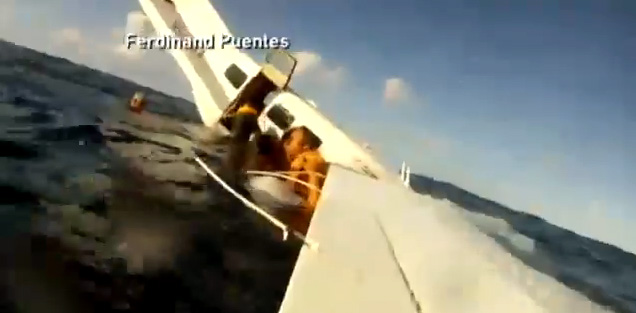Cessna 208B Caravan Ditching Video, Molokai, Hawaii, 2013
We have previously covered the graphic ditching of Sikorsky S-76C 9M-STE (MSN 760398) of MHS Aviation in the South China Sea on 12 December 2013, and a passenger video of the ditching and rescue.
Coincidentally, the day before (but in practice a couple of hours later due to the time difference), another ditching occurred, this time of a Cessna 208B Caravan off Hawaii, filmed by a passenger (Ferdinand Puentes). Sadly one person died in this accident (State Health Director Loretta Fuddy) and three people were seriously injured.
The NTSB report that:
On December 11, 2013, at 1522 Hawaiian standard time, a Cessna 208B, N687MA, sustained substantial damage following a loss of engine power and ditching into the Pacific Ocean near Kalaupapa, Hawaii. The airline transport pilot and two passengers were seriously injured, one passenger was fatally injured, and five passengers received minor injuries. Makani Kai Air was operating the flight under the provisions of 14 Code of Federal Regulations Part 135. Visual meteorological conditions prevailed for the cross-country flight, which had originated about 2 minutes before the accident. A company flight plan had been filed. The flight departed from the Kalaupapa airport on the island of Molokai, and was en route to Honolulu International airport, on the island of Oahu.
The pilot stated that shortly after takeoff, a loud bang was heard and there was a total loss of power. After a short glide, he performed an open ocean ditching. The airplane floated for approximately 25 minutes and then sank. All the passengers put on their life preservers and exited the airplane. US Coast Guard and Maui Fire and Rescue personnel recovered the passengers approximately 80 minutes later.
Local press subsequently interviewed the pilot.
UPDATE 23 May 2016: The NTSB final report includes:
All the passengers and the pilot exited the airplane through the rear right door, and the airplane remained on the water surface for approximately 25 minutes before it sank. One passenger swam to shore, and United States Coast Guard and Maui Fire and Rescue helicopters recovered the pilot and 7 passengers from the water about 80 minutes after the ditching.
Several passengers stated that the pilot did not provide a safety briefing before the flight. One passenger stated that the pilot asked how many of the passengers had flown over that morning and then said, “you know the procedures.”
The passenger who died before the first responders arrived was found wearing a partially inflated infant life vest. The autopsy of the passenger did not reveal any significant traumatic injuries, and the autopsy report noted that her cause of death was “acute cardiac arrhythmia due to hyperventilation.” Another passenger reported that he also inadvertently used an infant life vest, which he said seemed “small or tight” but “worked fine.”
If the pilot had provided a safety briefing, as required by Federal Aviation Administration regulations, to the passengers that included the ditching procedures and location and usage of floatation equipment, the passengers might have been able to find and use the correct size floatation device.
The National Transportation Safety Board determines the probable cause(s) of this accident as follows:
The loss of engine power due to the fracture of multiple blades on the compressor turbine wheel, which resulted in a ditching. The reason for the blade failures could not be determined due to secondary thermal damage to the blades.


Recent Comments